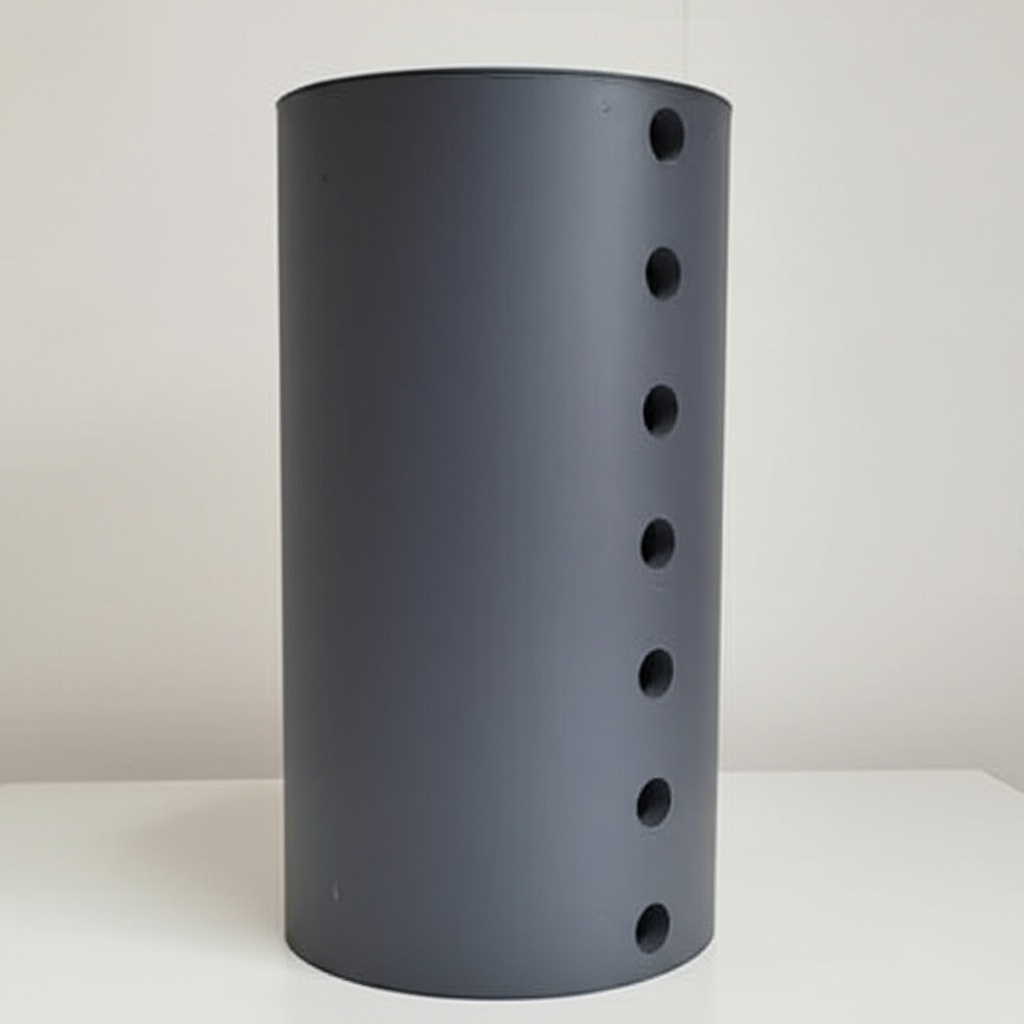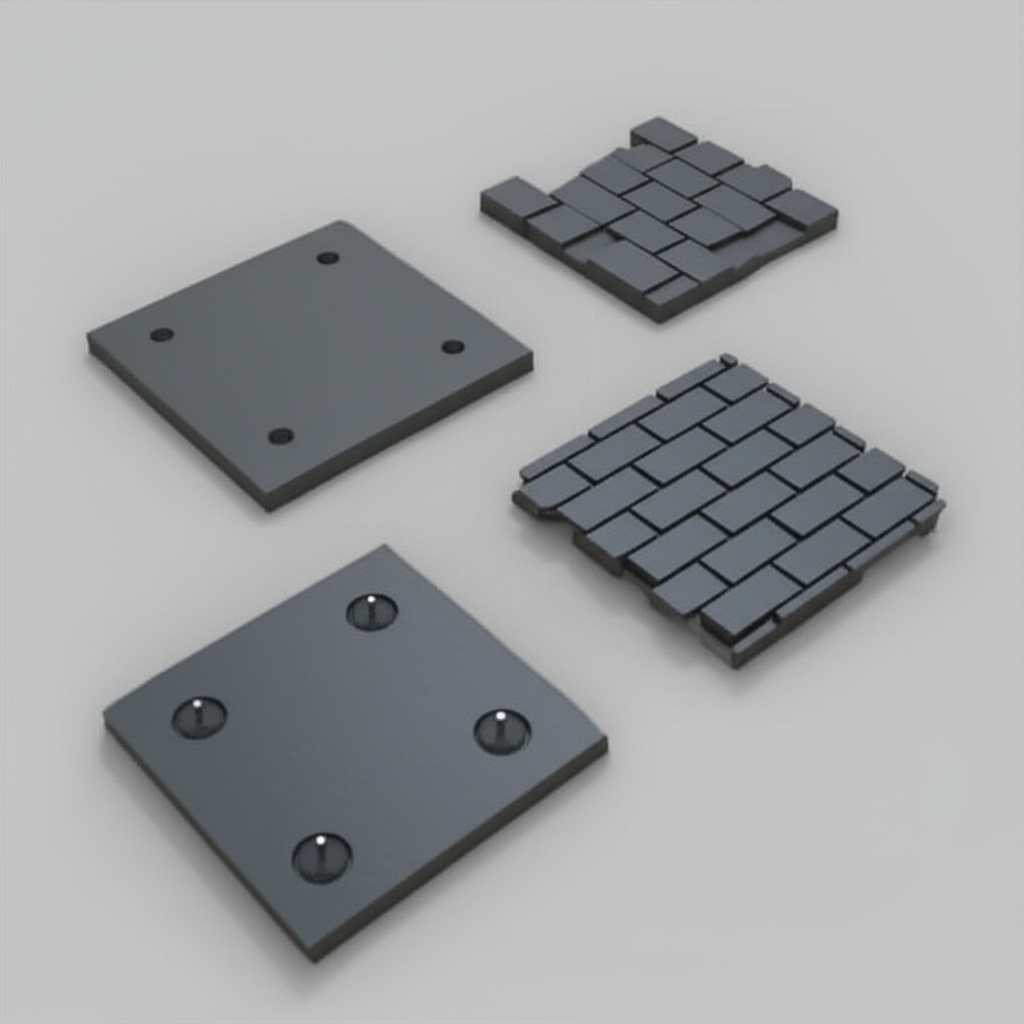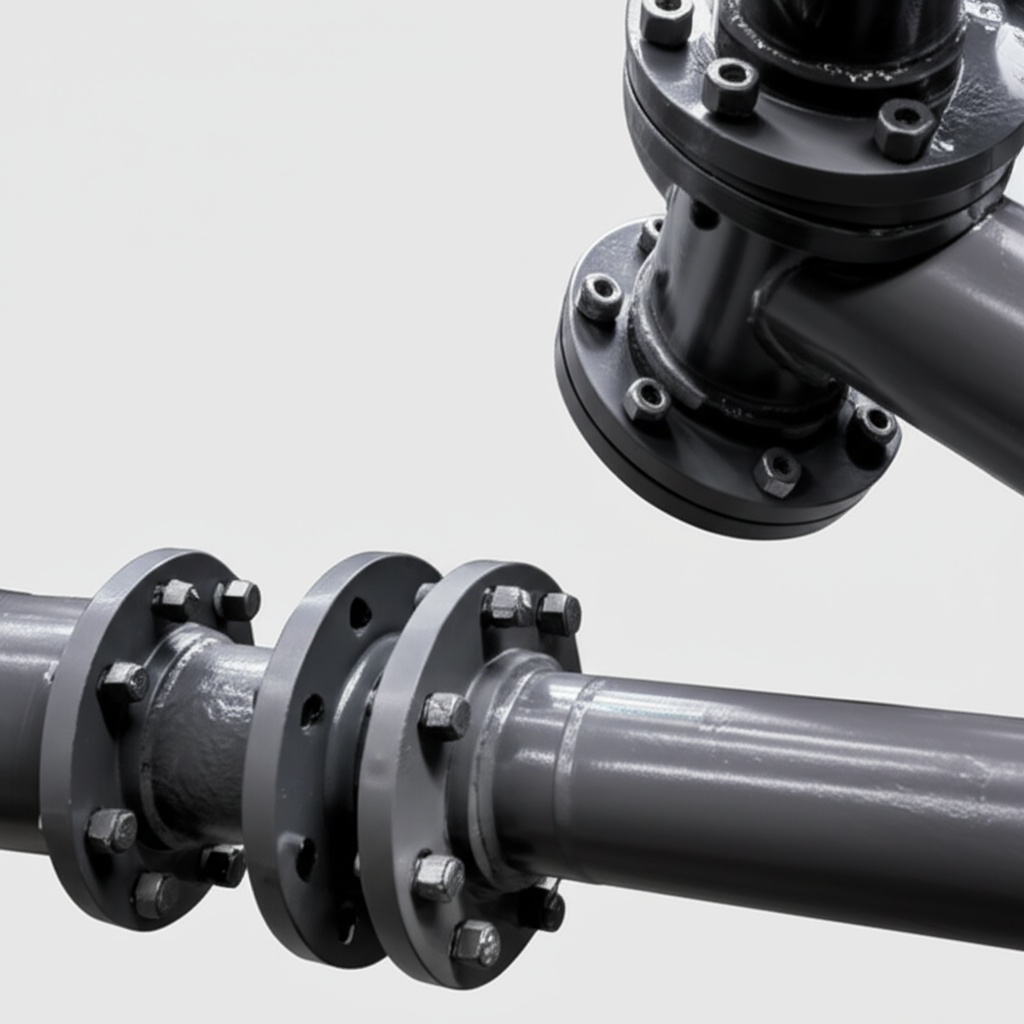SiC Substrates: The Foundation for Advanced Tech

Share
SiC Substrates: The Foundation for Advanced Tech
In the rapidly evolving landscape of advanced technology, the demand for materials that can withstand extreme conditions and deliver superior performance is paramount. Silicon Carbide (SiC) substrates have emerged as a critical enabling material, particularly in industries pushing the boundaries of innovation. From high-power electronics to cutting-edge aerospace applications, SiC substrates provide the robust foundation necessary for next-generation devices. This blog post delves into the world of SiC substrates, exploring their applications, advantages, design considerations, and how to source high-quality custom solutions for your specific needs.
1. Introduction: SiC Substrates – The Bedrock of Next-Generation Technology
Silicon Carbide (SiC) is a compound semiconductor material renowned for its exceptional physical and electronic properties. A SiC substrate is essentially a wafer or disc made from single-crystal SiC, upon which active semiconductor layers (epitaxial layers) are grown to fabricate electronic or optoelectronic devices. These substrates are not mere passive carriers; their quality directly influences the performance, reliability, and efficiency of the final device. The unique combination of wide bandgap, high thermal conductivity, high breakdown electric field strength, and superior mechanical stability makes SiC substrates indispensable for applications demanding high power, high frequency, and high-temperature operation. As technologies like 5G, electric vehicles, and renewable energy systems mature, the role of high-quality SiC substrates becomes increasingly crucial, acting as the very bedrock upon which future innovations are built. The ability to procure custom SiC substrates tailored to specific device requirements further amplifies their value, allowing engineers to optimize performance for even the most demanding industrial applications.
2. Key Industries Driving Demand for SiC Substrates
The exceptional properties of SiC substrates have led to their adoption across a diverse range of high-tech industries. Each sector leverages SiC’s unique advantages to overcome previous material limitations and unlock new levels of performance and efficiency.
- Semiconductors & Power Electronics: This is the largest market for SiC substrates. They are fundamental for manufacturing power devices like MOSFETs, Schottky diodes, and power modules used in power supplies, inverters, and variable frequency drives. SiC-based devices offer lower energy losses, higher switching frequencies, and higher operating temperatures compared to traditional silicon devices. This translates to more compact, efficient, and reliable power conversion systems.
- Automotive: The automotive industry, particularly in the electric vehicle (EV) sector, is a major driver of SiC substrate demand. SiC power modules in EV inverters, on-board chargers, and DC-DC converters lead to increased driving range, faster charging times, and reduced vehicle weight and volume. The ability to operate at higher temperatures also simplifies cooling system requirements.
- Aerospace & Defense: Aerospace and defense systems require components that are lightweight, robust, and capable of operating reliably in harsh environments. SiC substrates are used in radar systems, satellite power systems, and avionic power supplies due to their radiation hardness, high-temperature tolerance, and high power density.
- Renewable Energy: Solar inverters and wind turbine converters benefit significantly from SiC technology. The higher efficiency of SiC-based power conversion leads to greater energy harvesting and reduced system costs. Their durability is also an asset in remote or challenging installation environments.
- LED Manufacturing: While Gallium Nitride (GaN) is often grown on sapphire or silicon, SiC substrates offer a closer lattice match and better thermal conductivity for high-power GaN-based LEDs and laser diodes. This results in brighter, more efficient, and longer-lasting lighting solutions, especially in applications like industrial lighting, automotive headlamps, and large-scale displays.
- Industrial Machinery & Manufacturing: High-power motor drives, industrial heating systems, and welding equipment utilize SiC power devices for improved efficiency, precision, and control. The robustness of SiC ensures longevity in demanding industrial settings.
- Telecommunications: SiC substrates are finding applications in high-frequency power amplifiers for 5G base stations and other telecommunication infrastructure. Their ability to handle high power at high frequencies is critical for efficient signal transmission.
- Oil and Gas: Downhole drilling and sensing equipment in the oil and gas industry operate under extreme temperatures and pressures. SiC-based sensors and electronics offer superior reliability and performance in these challenging conditions.
- Rail Transportation: Modern trains and trams are increasingly using SiC-based auxiliary power units and traction inverters for improved energy efficiency, reduced size and weight of power systems, and lower operational costs.
- Nuclear Energy: SiC’s radiation resistance and high-temperature stability make it a candidate material for sensors and electronic components within nuclear power plants, contributing to safer and more reliable operation.
3. The Unmatched Advantages of Custom SiC Substrates
While standard SiC substrates offer significant benefits, the ability to customize these foundational components unlocks a new realm of possibilities for device optimization and application-specific performance. Customization allows engineers and designers to fine-tune substrate characteristics to precisely match the demands of their advanced technologies.
Key advantages of opting for custom SiC substrates include:
- Optimized Thermal Management: SiC boasts thermal conductivity roughly three times higher than silicon. Customization can further enhance this by specifying particular polytypes or surface modifications that optimize heat dissipation paths, crucial for high-power density devices. This leads to lower operating temperatures, improved reliability, and reduced need for bulky cooling systems.
- Enhanced Electrical Performance:
- High Breakdown Voltage: SiC’s breakdown electric field is about ten times that of silicon. Custom substrates can be engineered with specific doping levels (e.g., N-type or semi-insulating) and defect densities to maximize this property, enabling devices to handle much higher voltages without failure.
- Low On-Resistance: For power switching applications, minimizing on-resistance is key to reducing conduction losses. Custom substrate thickness and doping profiles can be tailored to achieve the lowest possible on-resistance for a given device design.
- High-Frequency Operation: SiC’s high electron saturation velocity allows for higher switching frequencies. Substrate properties can be optimized to support these fast switching speeds, leading to smaller passive components and more compact systems.
- Superior Mechanical Robustness: SiC is an extremely hard and mechanically stable material. Customization can involve specific dimensional tolerances, edge profiling, and backside processing to enhance the substrate’s ability to withstand the rigors of downstream processing (like epitaxy and device fabrication) and ensure long-term reliability in mechanically demanding environments.
- Tailored Chemical Inertness and Purity: SiC is highly resistant to chemical attack, even at elevated temperatures. Custom substrate manufacturing processes can ensure ultra-high purity levels and specific surface chemistries, which are critical for sensitive semiconductor device fabrication where contamination can degrade performance or yield.
- Application-Specific Geometries and Orientations:
- Diameter and Thickness: Substrates can be produced in various diameters (e.g., 100mm, 150mm, 200mm) and precise thicknesses tailored to equipment capabilities and device requirements.
- Crystal Orientation (Off-cut): The angle and direction of the off-cut from a specific crystal plane (e.g., 4° off-axis from the (0001) plane for 4H-SiC) are critical for high-quality epitaxial growth. Customization allows for precise control over these parameters.
- Flats and Notches: Specific flats or notches for wafer orientation and handling can be incorporated according to customer specifications.
- Improved Device Yield and Reliability: By starting with a substrate that is perfectly matched to the intended application and subsequent processing steps, manufacturers can often improve device yields and enhance the overall reliability and lifetime of their end products. Custom specifications for defect density (e.g., micropipe density, basal plane dislocations) are crucial here.
Partnering with a supplier capable of delivering high-quality, custom SiC substrates is therefore a strategic advantage for companies operating at the forefront of technology.
4. Navigating SiC Polytypes and Grades for Substrate Applications
Silicon Carbide is unique in its ability to exist in many different crystal structures, known as polytypes. While over 250 SiC polytypes have been identified, only a few are commercially significant for substrate applications due to their specific electronic and physical properties. Understanding these polytypes and available grades is crucial for selecting the right substrate for a given device.
The most common SiC polytypes used for substrates are:
- 4H-SiC (Hexagonal SiC): This is currently the most widely used polytype for power electronic devices.
- Properties: It offers a wider bandgap (~3.26 eV), higher electron mobility (especially along the c-axis), and more isotropic properties compared to 6H-SiC. This translates to lower on-resistance and higher switching frequencies in devices.
- Applications: Predominantly used for high-voltage power MOSFETs, Schottky diodes, and high-frequency devices.
- 6H-SiC (Hexagonal SiC): Historically, 6H-SiC was more common due to easier crystal growth, but 4H-SiC has largely superseded it for most power applications.
- Properties: It has a slightly smaller bandgap (~3.03 eV) and lower electron mobility compared to 4H-SiC. However, it can exhibit very high crystal quality.
- Applications: Still used for some high-frequency RF devices, certain types of LEDs, and as a substrate for GaN epitaxy in some cases due to good lattice matching with GaN. Also finds use in some high-temperature sensors.
- 3C-SiC (Cubic SiC): Also known as β-SiC, this polytype has a smaller bandgap (~2.36 eV) but potentially higher electron mobility than 4H or 6H.
- Properties: Isotropic properties. The main challenge has been growing high-quality, large-diameter 3C-SiC crystals directly. Often grown heteroepitaxially on silicon substrates, which introduces stress and defects.
- Applications: Research interest for specific applications like MEMS, sensors, and potentially some MOSFETs if crystal quality issues can be overcome. Not as prevalent for mainstream power devices.
Beyond polytypes, SiC substrates are available in different grades based on their electrical conductivity and quality:
Table 1: Common SiC Substrate Grades and Their Characteristics
| Grade | Typical Dopant | Resistivity Range (Ω·cm) | Key Characteristics | Primary Applications |
|---|---|---|---|---|
| N-type (Conductive) | Nitrogen (N) | 0.015 – 0.028 (for 4H-SiC) | Low resistivity, serves as a conductive path for vertical current flow in devices. Enables Ohmic contact formation. | Power MOSFETs, Schottky Barrier Diodes (SBDs), IGBTs (less common in SiC), LEDs. |
| Semi-Insulating (SI) | Vanadium (V) doping or intrinsic (High Purity Semi-Insulating – HPSI) | > 105 (often > 109 for HPSI) | High resistivity, minimizes RF losses and substrate parasitic capacitance. Provides electrical isolation. | RF power amplifiers (e.g., for 5G base stations), MESFETs, high-frequency devices, some sensor applications. HPSI grades are preferred for reduced vanadium-related trapping effects. |
| P-type (Conductive) | Aluminum (Al) or Boron (B) | Varies, typically higher than N-type for similar doping levels due to lower hole mobility. | Less common for substrates in majority carrier devices but can be used for specific device structures or as a starting material for certain epitaxial processes. | Some bipolar devices (BJTs), specific sensor designs, research purposes. |
The choice of polytype and grade is a fundamental decision in device design. For instance, high-power switching applications will almost exclusively use N-type 4H-SiC substrates, while high-frequency RF applications will lean towards semi-insulating (often HPSI 4H-SiC or high-quality 6H-SiC) substrates. Defect density (micropipes, dislocations, stacking faults) is another critical grading parameter, with prime grades having the lowest defect counts essential for high-yield, high-performance device manufacturing.
5. Critical Design Considerations for Optimal SiC Substrate Performance
Designing or selecting the right SiC substrate involves careful consideration of several parameters that directly impact the subsequent epitaxial growth and final device performance. These considerations go beyond just choosing a polytype and grade, delving into the physical and crystallographic details of the wafer.
- Crystal Orientation and Off-Cut Angle:
- SiC substrates are typically supplied with their surface cut a few degrees off-axis from a primary crystallographic plane (e.g., the (0001) basal plane). For 4H-SiC, common off-cut angles are 4° or 8° towards the <11-20> direction.
- Importance: This intentional misorientation is crucial for high-quality epitaxial growth, particularly for step-flow growth mode, which helps reduce the formation of certain types_of crystal defects (like 3C inclusions) in the epitaxial layer. The choice of off-cut angle and direction can influence doping incorporation, surface morphology, and defect propagation.
- Diameter and Thickness:
- Diameter: Common diameters include 100mm (4 inches), 150mm (6 inches), with a transition towards 200mm (8 inches) underway to reduce per-die cost. The choice often depends on the foundry’s processing capabilities and production volume.
- Thickness: Substrate thickness needs to be sufficient to provide mechanical support during processing and handling, yet not so thick as to unnecessarily increase material cost or, for conductive substrates, series resistance. Typical thicknesses range from 350 µm to 500 µm for 100mm and 150mm wafers. Custom thicknesses are often required.
- Surface Quality and Preparation:
- Epi-readiness: The substrate surface must be exceptionally smooth and free of subsurface damage, contaminants, and particles for successful epitaxy. This is typically achieved through chemo-mechanical polishing (CMP). An “epi-ready” surface is critical.
- Surface Roughness (Ra): Typically specified in the angstrom range (e.g., Ra < 0.5 nm or even < 0.2 nm).
- Scratches, Stains, and Particles: Strict limits are placed on the presence of any visible surface defects.
- Defect Density: This is one of the most critical parameters.
- Micropipe Density (MPD): Micropipes are hollow-core screw dislocations that propagate from the substrate into the epitaxial layer, acting as fatal defects for most devices. MPD is typically specified as < 1 cm-2 for prime grades, with advancements pushing towards zero micropipe wafers.
- Basal Plane Dislocation (BPD) Density: BPDs in the substrate can lead to stacking faults in the epitaxial layer, which degrade device performance, particularly for bipolar devices and causing Vf drift in PiN diodes.
- Threading Screw Dislocations (TSD) and Threading Edge Dislocations (TED): These also impact device performance and reliability.
- Low defect density is crucial for achieving high device yields, especially for large-area devices.
- Resistivity Uniformity: For conductive substrates, uniform resistivity across the wafer is important for consistent device characteristics. For semi-insulating substrates, maintaining high resistivity uniformly is key.
- Bow and Warp: These parameters describe the deviation of the wafer surface from an ideal plane. Excessive bow or warp can cause problems in photolithography, epitaxy, and other processing steps. Specifications typically limit bow to < 30-50 µm and warp to < 50-70 µm, depending on diameter.
- Total Thickness Variation (TTV): The difference between the maximum and minimum thickness across the wafer. Tight TTV control is essential for uniform processing.
- Edge Exclusion: A specified area around the perimeter of the wafer (e.g., 3-5mm) that may not meet all prime quality specifications. Minimizing this area maximizes usable die per wafer.
- Identification Marks: Laser-scribed identification marks (SEMI standard) are used for wafer traceability. The quality and placement of these marks are important.
Careful specification of these design parameters, in consultation with a knowledgeable SiC substrate supplier, is essential to ensure the substrate is optimized for the intended device structure and fabrication process, ultimately leading to higher-performing and more reliable end products.
6. Achieving Precision: Tolerance, Surface Finish & Dimensional Accuracy in SiC Substrates
The journey from a raw SiC boule to a high-performance substrate involves a series of intricate shaping, machining, and finishing processes. Achieving stringent tolerances, an impeccable surface finish, and precise dimensional accuracy are paramount for the successful fabrication of advanced semiconductor devices. These factors directly influence epitaxial layer quality, photolithographic resolution, and overall device yield.
Key Parameters and Achievable Specifications:
- Diameter Tolerance:
- Ensures wafers fit correctly into processing equipment.
- Typical tolerance: ±0.1mm to ±0.2mm of the nominal diameter (e.g., 100mm, 150mm).
- Thickness Tolerance:
- Crucial for consistent thermal and electrical properties, and for mechanical handling.
- Typical tolerance: ±10µm to ±25µm from the nominal thickness (e.g., 350µm, 500µm).
- Total Thickness Variation (TTV):
- Measures the uniformity of thickness across the wafer. Critical for uniform epitaxial growth and planarization processes.
- Achievable values: < 10µm, with premium grades aiming for < 5µm.
- Bow:
- The concavity or convexity of the median surface of a free, unclamped wafer. Affects lithography focus.
- Achievable values: Typically < 30µm, with tighter specs for larger diameters or demanding applications.
- Warp:
- The difference between the maximum and minimum distances of the median surface from a reference plane. Indicates overall wafer flatness. Affects chucking and handling.
- Achievable values: Typically < 40µm.
- Surface Roughness (e.g., Ra, Rms, Rq):
- Si-face (Polish Side): This is the critical surface for epitaxial growth. It must be atomically smooth.
- Achievable Ra: < 0.5 nm, often < 0.2 nm after Chemical Mechanical Polishing (CMP). Some specifications push for < 0.1 nm.
- C-face (Back Side): Typically ground or lapped, may also be polished depending on application (e.g., for double-side polished wafers or specific thermal contact requirements). Roughness is generally higher than the Si-face.
- Si-face (Polish Side): This is the critical surface for epitaxial growth. It must be atomically smooth.
- Edge Profile and Chipping:
- Wafers typically have a rounded or chamfered edge to prevent chipping during handling and processing. The profile must be consistent.
- Strict limits on the size and number of edge chips.
- Orientation Flat or Notch Precision:
- Flats (for smaller diameters) or Notches (for larger diameters, e.g., SEMI standard) are used to orient the wafer in processing equipment and indicate crystallographic orientation.
- Length and angular tolerance of these features are critical. For example, flat length tolerance might be ±1mm, and angular orientation tolerance ±0.5°.
- Site Flatness (e.g., STIR – Site Total Indicated Reading):
- Measures the flatness over localized areas (sites) where individual dies will be fabricated. Extremely important for fine-line lithography.
- Achievable values depend on site size but can be sub-micron.
- Surface Defects:
- Specifications will limit the number and size of scratches, pits, stains, particles, and other visual defects on the polished surface. Automated inspection systems are used for quantification.
- Subsurface damage from grinding and lapping must be completely removed by the CMP process.
Table 2: Typical Dimensional and Surface Finish Specifications for Prime SiC Substrates
| Parameter | Typical Specification (150mm N-type 4H-SiC Example) |
|---|---|
| Diameter | 150mm ± 0.2mm |
| Thickness | 350µm ± 15µm or 500µm ± 20µm |
| Primary Flat/Notch Orientation | Perpendicular to <11-20> ± 0.5° (or other specified direction) |
| Off-cut Angle | 4.0° ± 0.25° (towards specified direction) |
| TTV | < 10µm (often < 5µm for premium) |
| Bow | < 30µm |
| Warp | < 40µm |
| Si-Face Surface Roughness (Ra) | < 0.2 nm |
| Micropipe Density (MPD) | < 0.5 cm-2 (or specified by grade) |
| Edge Exclusion | 3mm |
Achieving these tight specifications requires sophisticated metrology equipment and robust process control throughout the substrate manufacturing chain. For procurement managers and technical buyers, it’s essential to clearly define these requirements with their supplier to ensure the substrates meet the demands of their specific fabrication lines and device designs.
7. Essential Post-Processing Needs for High-Quality SiC Substrates
After the initial slicing of SiC boules and the primary shaping (grinding and lapping) of the wafers, several critical post-processing steps are necessary to transform them into high-quality, “epi-ready” substrates. These steps are designed to achieve the stringent surface finish, cleanliness, and dimensional tolerances required for successful epitaxial growth and device fabrication.
Key post-processing stages include:
- Chemical Mechanical Polishing (CMP):
- This is arguably the most crucial post-processing step for achieving an atomically smooth and damage-free surface on the Si-face (and sometimes C-face) of the SiC substrate.
- CMP involves polishing the wafer using a chemical slurry (containing abrasive particles and reactive chemicals) and a polishing pad. The process combines mechanical abrasion with chemical etching to remove material.
- Goal: To eliminate subsurface damage induced by prior grinding and lapping, reduce surface roughness to angstrom levels (e.g., Ra < 0.2 nm), and achieve excellent surface planarity.
- Multiple CMP steps with different slurries and pads may be used to achieve the final desired finish.
- Advanced Cleaning Processes:
- After CMP and other handling steps, substrates must undergo rigorous cleaning to remove any residual slurry particles, metallic contaminants, organic residues, and other impurities.
- Cleaning sequences often involve multiple steps, including:
- Solvent cleaning (e.g., with acetone, IPA).
- Acidic solutions (e.g., Piranha etch (H2SO4 + H2O2), SC-2 (HCl + H2O2 + H2O)) to remove organic and metallic contaminants.
- Alkaline solutions (e.g., SC-1 (NH4OH + H2O2 + H2O)) to remove particles.
- DI water rinsing and drying (e.g., spin rinse drying, Marangoni drying).
- The goal is to achieve a particle-free, atomically clean surface, often verified by techniques like Light Scattering Surface Inspection.
- Surface Inspection and Metrology:
- Throughout and after post-processing, extensive inspection and metrology are performed.
- Automated Surface Scanners: Tools like KLA-Tencor Candela or Surfscan are used to detect and map particles, scratches, pits, and other surface defects with high sensitivity.
- Atomic Force Microscopy (AFM): Used to quantify surface roughness at the nanoscale and image surface morphology.
- X-Ray Diffraction (XRD) / X-Ray Topography (XRT): To verify crystal orientation, off-cut angle, and assess crystalline quality (e.g., defect density, strain).
- Optical Microscopy: For visual inspection of defects, edge quality, and laser marks.
- Thickness, TTV, Bow, Warp Measurement Systems: To ensure dimensional parameters are within specification.
- Backside Processing (Optional but common):
- While the front (Si-face) gets the most attention, the backside (C-face) may also undergo specific processing.
- Backside Grinding/Lapping: To achieve target thickness and improve backside parallelism.
- Backside Polishing: For applications requiring double-side polished (DSP) wafers, or improved thermal contact.
- Backside Metallization: In some cases, a metal layer (e.g., Ti/Ni/Ag) may be deposited on the backside of conductive substrates to facilitate Ohmic contact formation or improve die attach during device packaging. This is typically done by the device manufacturer but can sometimes be offered as a substrate-level service.
- Laser Marking:
- SEMI-standard or custom laser marks are applied to the wafer (typically on the backside or frontside edge exclusion zone) for identification and traceability throughout the fabrication process. The marking process must be clean and not induce stress or particles.
- Edge Profiling/Chamfering:
- Ensures smooth, rounded edges to minimize chipping during handling and processing, which can be a source of particle generation.
- Final Clean and Packaging:
- A final cleaning step is performed before packaging the substrates in sp
- A final cleaning step is performed before packaging the substrates in sp

About the Author: Sicarb Tech
We provide clear and reliable insights into silicon carbide materials, component manufacturing, application technologies, and global market trends. Our content reflects industry expertise, practical experience, and a commitment to helping readers understand the evolving SiC landscape.




